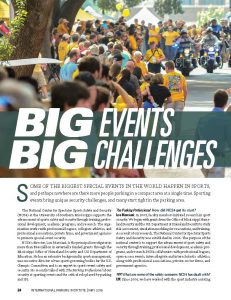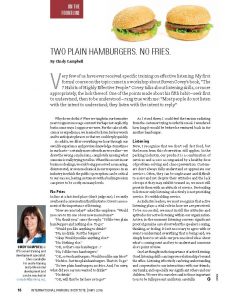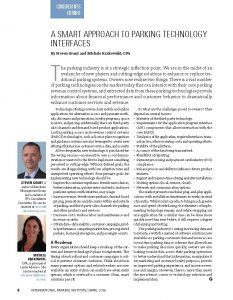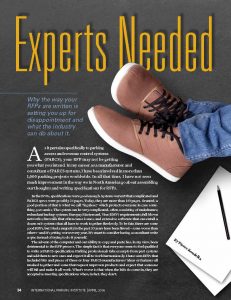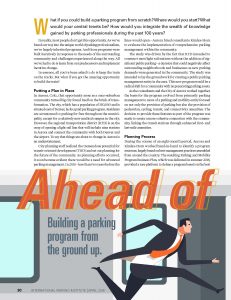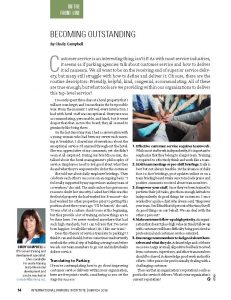by Khurshid Hoda
Crime prevention through environmental design boosts safety with relatively easy steps for both new builds and existing-structure retrofits.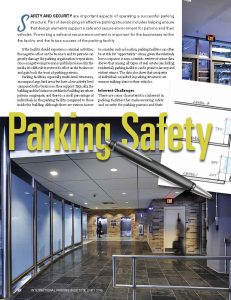
SAFETY AND SECURITY are important aspects of operating a successful parking structure. Part of developing an effective parking structure includes helping ensure that design elements support a safe and secure environment for patrons and their vehicles. Promoting a safe and secure environment is important for the businesses within the facility and the future success of the parking facility.
If the facility should experience criminal activities, the negative effect on the business and its patrons can greatly damage the parking organization’s reputation. Once a negative impression is publicly released in the media, it is difficult to reverse its effect on the businesses and gain back the trust of parking patrons.
Parking facilities, especially multi-level structures, encompass large land areas but have a low activity level compared to the businesses they support. Typically, the building and the businesses within the building are where patrons congregate, and there is a small percentage of individuals in the parking facility compared to those inside the building. Although there are various factors to consider, such as location, parking facilities can often be at risk for “opportunity” crime, given the relatively low occupancy. A non-scientific review of crime data shows that among all types of real estate (excluding residential), parking facilities can be prone to larceny and violent crimes. The data also show that a majority of individuals assaulted in parking structures are women walking alone to their vehicles.
Inherent Challenges
There are some characteristics inherent in parking facilities that make ensuring safety and security for parking patrons and their vehicles a challenge. A criminal’s vehicle looks like nearly every other vehicle so it would likely not be noticed in a parking facility. Additionally, blind corners, sightline obstructions, and parked vehicles can provide a hiding place for a criminal and potentially block the lighting in the area where a criminal could hide.
Often, a parking patron’s ability to see and be seen is reduced because parking structures are partially or fully enclosed, elevated, have multiple levels, or include ramps that provide vehicular access to multiple floors of the facility. Although there is no one perfect solution when determining how to address the security of a parking structure, providing reasonable safety and security in the parking facility is in the best interest of the owner and the traveling public. Reasonable security measures will help to deter and prevent criminal activity.
For a security measure to be a deterrent, it has to have a psychological effect on a criminal. It should discourage potential criminals from committing a criminal act. Examples of deterrence are adequate lighting, closed-circuit TV (CCTV) monitoring, and signs posted indicating security patrols within and around the facility.
The opportunities for criminal activity in a parking facility can be significantly reduced by properly planning and implementing security measures in the design and construction of the parking facility. The security measures should seek to affect both the psyche of the criminal mind and the parking patron, as well as improve the physical conditions within the facility with proven security enhancements.
By Design
Incorporating security features in the design of a parking structure is one of the best examples of crime prevention through environmental design (CPTED). This approach deters criminals by making them feel trapped, out of place, exposed, and concerned that others inside and are many design elements that enhance the CPTED approach—we’ll discuss them shortly.
Any measure or technique not requiring human interaction or response, including lighting, glass-backed elevators, open or glass-enclosed stairs, etc., is defined as passive security. Passive security features also can be referred to as security-by-design. This approach refers to specific parking facility design elements, features, materials, and systems that can enhance the overall security of the facility without active human interaction. Passive security measures are cost-effective and last the life of the parking facility. If these measures are implemented and maintained well, they significantly contribute to patrons’ feeling of safety and comfort within the parking facility.
Based on input received from various owners, parking consultants, and this author’s experience, the following five passive security features have a significant positive effect on parking structure security:
1. Lighting Design. Parking and security consultants strongly agree that adequate and uniform lighting is the first line of defense and most effective deterrent against criminal activities in parking facilities. Several studies have been conducted by security experts that prove sufficient lighting has reduced crime in an area.
Eliminating dark areas deters crime, promotes enhanced user comfort, and improves the overall perception of safety. Ample lighting helps encourage safe movement of pedestrians and vehicles within the parking facility and improves internal wayfinding.
Lighting levels are generally not mandated by building codes, other than certain minimum levels required for emergency egress. The industry guidelines for parking facility lighting are established by the Illuminating Engineering Society of North America (IESNA). These guidelines are not legal building codes, but failure to comply with IESNA recommendations does carry significant liability risks.
For improved safety and increased customer security in parking facilities, it is suggested that these lighting levels be increased by 50 percent and motion-sensor controlled lighting be installed. The security experts agree that motion-sensor systems will further enhance patrons’ safety and reduce energy costs. In high-crime areas, some security experts suggest increasing the IESNA light levels by 100 percent. Of course, these suggestions are based on the understanding that the project budget could support the cost of higher light levels (first and operating and maintenance [O&M] costs). However, with advancements in energy-saving light fixtures and building management systems, it is expected the O&M costs would be significantly lower than those of older fixtures and systems.
Lighting fixtures should be paired in each parking bay. The paired-fixture approach improves lighting uniformity and provides a certain level of redundancy should a single lamp failure occur. Additionally, this will minimize shadows created by parked vehicles, as well as reduce the lighting glare in the drive aisles. The paired fixture approach is also beneficial if a CCTV system is used.
Staining ceiling and beams of parking facilities is a way of increasing reflectance of concrete surfaces, thus increasing overall brightness and improving overall parking environment. This approach also improves overall lighting uniformity because stained concrete uniformly reflects light on the driving surface. Staining or painting walls may encourage graffiti and will become a regular maintenance issue. Therefore, wall staining is not recommended.
2. Clear-Span Construction. Clear-span construction technique reduces the number of columns within the parking facility, creating an open environment, better visibility, and minimizing potential hiding places.
One of the factors that should be evaluated is the structural system. Structural beams in cast-in-place (CIP) systems are generally located at more than 25 feet apart. The wider span provides for a higher ceiling perception, which provides more open space, better lighting from fewer fixtures, and better visibility of signage. All these factors improve visibility, thus enhancing the safety of patrons and their vehicles.
3. Glass-backed elevators and open stairs. The more open and visible parking areas can be made, the better they are for passive security purposes. The theory behind this is that criminals are less likely to assault a parking patron in front of a clear glass window or open stairs than in an enclosed area. Therefore, it is recommended that parking structures have glass-backed elevators and open stairs.
4. Landscape design. Almost all parking structure projects include some level of landscape design. Inappropriate placement of shrubbery, hedges, and trees can restrict line of sight for pedestrian and vehicular traffic and may negatively affect parking safety and security. Therefore, landscaping should be kept low to the ground to minimize potential hiding places around the parking facility. It is important to properly maintain landscaping elements because if they are allowed to grow too tall, they may cause safety and security concerns.
5. Human activity. Legitimate human activity in any parking facility improves the safety and security of patrons and their vehicles. However, it is difficult to establish appropriate and legitimate human activity in a parking structure. To some extent, locating a parking office in a parking facility achieves this purpose. Additionally, providing pedestrian access to mixed-use elements (if available) through the parking structure, without sacrificing pedestrian safety, may also achieve human activity in parking structures. These features will assist in improving patron and vehicle safety.
Other Security Enhancements
Depending on the use and type of parking structures, the following measures may be implemented to further enhance parking security:
- The addition of escalators (generally used in parking structures at airports and large malls) provides vertical movement for pedestrians with a high visibility, which is an excellent passive security feature inside a parking structure.
- Security screens protect potential hiding places, such as areas below the first flight of stairs.
- The addition of convex mirrors in elevator cabs allows patrons to see if anyone is hiding inside the cab before they enter.
- Glass panels in stairwell doors improve visibility.
- Curbs and wheel-stops should be minimized as they are potential trip hazards. For enhanced visibility, faces and tops of curbs/ wheel stops should be painted yellow.
- Signs should not impede drivers’ vision or create hiding places for intruders.
The above discussion and suggestions are by no means a complete list of measures for all parking structures. For each parking structure, a site-specific safety and security evaluation should be conducted, and appropriate measures should be implemented including “active” security measures (if needed) during design and construction phases.
KHURSHID HODA is a parking practice builder with Kimley-Horn and Associates. He can be reached at khurshid.hoda@kimley-horn.com.

